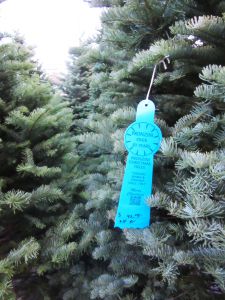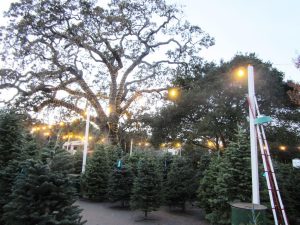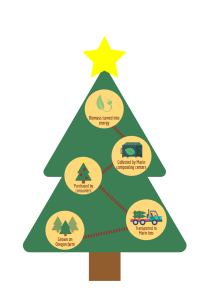Eight in 10 American households purchased a Christmas tree in 2014, according to a Pew Research survey. Out of these millions of people, many may not consider the life of a Christmas tree beyond the few golden weeks it lights up a house. In actuality, it takes years for a tree to reach a tree lot, and it does not magically disappear after it is laid on the curb for pick up.
Origin and Growth

Carla and Jon Pronzini, the owners of Pronzini Christmas Tree Farms, begin preparing for the holiday season in early spring. Currently, the Pronzinis have approximately 750,000 trees growing on their 500-acre farm in Salem, Oregon.
“We plant in February, March, and April when it is still wet up here,” retail manager Carla Pronzini said.
According to Carla Pronzini, they purchase seedlings called “plugs,” which are about six to eight inches tall, from nurseries to plant on their farm.
The trees are relatively low maintenance from the age of one to four years. Then at four to five years, farmers begin trimming the trees and sheering them into a proper shape, according to Carla Pronzini.
The Pronzinis grow several varieties of fir trees―Douglas, Fraser, Grand, Noble, Nordman, and Silvertip Firs―all of which have distinct characteristics. While the Nordman Fir and Grand Fir are denser symmetrical trees, Silvertip and Fraser have a more natural non-uniform shape.
The Douglas Fir and Noble Fir are some of the most popular varieties of Christmas trees in the United States. The Douglas fir accounts for 47 percent of trees grown in the Northwest, and the Noble Fir accounts for 45 percent of Christmas trees grown in the United States, according to the Pacific Northwest Christmas Tree Association.
Trees continue to grow for about six to ten years and are harvested at a variety of heights, ranging from four to nine feet, depending on age, according to Pronzini.
Though most Christmas trees are harvested when they are under 10 feet, a fully grown fir tree can grow from 30 ft to over 200 ft depending on the species, according to the National Christmas Tree Association (NCTA).
Transport and Retail
The purchase of a Christmas tree holds different meaning for different families. For some it is an annual ordeal, running through a maze of trees, and pointing at nearly each one before finally shouting “Yes, this is the perfect one.” Others, however, make a quick stop at a big-box store, checking the errand off their list of fundamental holiday chores.
The American Christmas tree industry is massive. In 2014, 26.3 million live Christmas trees were purchased in the United States with a total retail value of 1.4 billion, according to the NCTA.
From late November through Christmas, the Pronzini company makes shipments to the Bay Area twice a week. Pronzini Christmas Trees are sold in six Bay Area lots, including the Bon Air Center and Civic Center in Marin, according to Carla Pronzini.
“The trees [are] loaded into trucks and sent down to California,” Carla Pronzini said.
The trees also can only maintain freshness for about a week before needing water, so frequent shipments are necessary throughout December, according to Carla Pronzini.
“Our first shipment goes down the Sunday before Thanksgiving for large commercial trees that go in hotels or public centers,” Pronzini said.
The Bon Air center lot opened the day after Thanksgiving.
Junior Duncan Kleinfeld has worked at the lot every winter since his freshman year. He calls himself a “floater,” meaning that he walks around the lot advising customers by giving them information so they can find their ideal tree.
“[The job] originally started out as a way to make some money,” said Kleinfield. “But I have developed a friendship with the owner and a fondness of helping people [choose] their trees.”
According to Kleinfield, some customers are very particular when selecting their trees; however, he said he appreciates learning to deal with picky customers because it will eventually benefit him in the future, when he plans to work in retail and marketing.
“I love to see the smiles on the children’s faces and the parents’ reactions to finding the perfect tree. That is just something you cannot experience doing anything else,” Kleinfeld said.
In 2014, 85 percent of Christmas tree consumers purchased pre-cut trees from retail lots, chain stores, and nurseries, according to the NCTA.
After being distributed to locations for sale, Christmas trees are bought and taken into millions of homes, where they stand dressed in strings of lights and reflective ornaments, celebrating the last stages of their life.
Disposal and Renewal
When January arrives and the needles begin to dry, families unhook their ornaments. Many drag their barren tree to the curb, where it is picked up by disposal services. The Christmas tree then serves another purpose beyond holiday decoration.

Sanitation and composting services in Marin collect trees in January, taking them to destinations where they can be renewed for other uses, according to Jim Iavarone, managing partner of Mill Valley Refuse. Mill Valley Refuse serves Mill Valley, Tiburon and Corte Madera, while Marin Sanitary, another disposal service, covers most of Central Marin.
According to Iavarone, Mill Valley Refuse picks up approximately 10,000 trees each January from its customers. They then ship the trees in trucks to the Waste Management (WM) Redwood Landfill and Compost Center, which is located in Novato.
Waste Management’s technical coordinator Alicia McCutcheon supervises the composting process. Redwood Landfill receives approximately 100 tons of Christmas trees annually, according to McCutcheon.
When the Christmas trees and other green waste arrive at the facility, they are fed into a grinder and shredded into six-inch pieces. These six-inch pieces are then moisture conditioned with water from one of two stormwater ponds.

Once the chips contain 60 percent moisture, they are taken to the 26 composting bays, where the composting process begins. The waste is first covered with six inches of finished compost that seals it and acts as a filter.
To create a proper environment for the bacteria, McCutcheon adjusts internal temperature and the amount of air in the compost. The bacteria then break down the compost for 28 days.
“We then place [the compost] in one of our adjacent fields to cure, which means it breaks down even further,” McCutcheon said, adding that the compost is then filtered to a fine texture and sold to local vineyards and businesses.
Similarly to Mill Valley Refuse, Marin Sanitary also has an estimated collection of 10,000 trees, according to Chance Shelley, Marin Sanitary Community and Outreach Coordinator.
While some trees are shredded and composted at Marin Sanitary’s San Rafael facility, others are shipped to biomass treatment centers throughout California, according to Shelley.
The Christmas trees are used as biofuel, a renewable energy source that contributes to five percent of U.S. energy production, according to the Institute for Energy Research.
A Christmas tree witnesses more than a warm fire and a visit from Santa Claus during the winter season. It endures years of growth in preparation for its primary purpose―to become a comforting symbol of holiday joy.




























